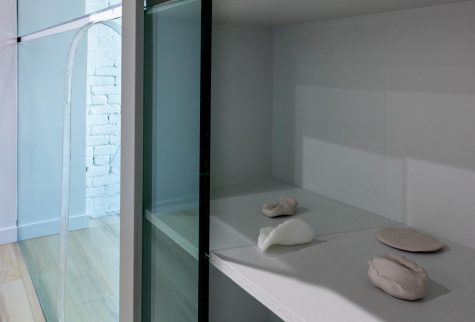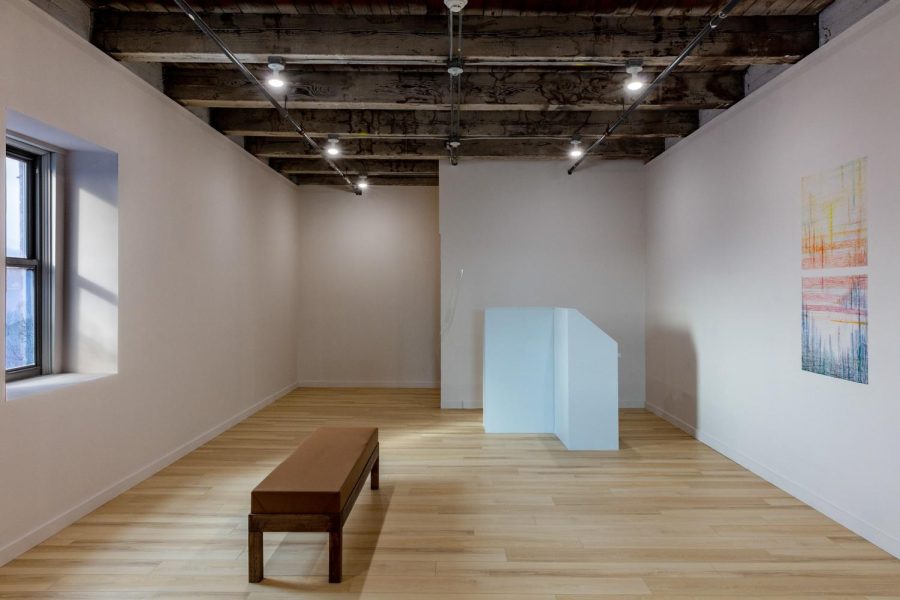Mattress Factory’s ‘HalfDream: Another Room’ exhibit conveys dreams, human commonality
Image courtesy of Danny Bracken
The Mattress Factory’s “HalfDream: Another Room” exhibit by artist Doreen Chan.
December 8, 2022
Walking into the Mattress Factory’s “HalfDream: Another Room” exhibit, guests notice a range of peculiar objects paired together 一 a sunrise melting into a sunset, a clock and a fish tank.
While these objects don’t seem natural together, artist Doreen Chan seeks to prove that what they symbolize is where they compare. In realizing the harmony of these objects, she hopes guests can find similarities among each other.
Steph Neary, creative arts manager at Vault Studio, said Chan sought to connect people with different political and cultural backgrounds through this exhibit.
“It’s like a taboo subject, no one seems to want to know your dreams. Doreen, she wants to know your dreams,” Neary said.
“HalfDream: Another Room” launched at The Mattress Factory on Friday. Composed of multimedia displays made from wood, acrylic and resin, each piece of the exhibit mirrors the recurring dreams everyday people experience. The fact that many people seem to have abstract recurring dreams that reflect their daily lives enables them to recognize the overall connection of humanity.
Chan, the artist who has collaborated with Vault Art, an organization that supports artists with intellectual disabilities, came to Pittsburgh from Hong Kong. She said she included the image of the clock to convey one Pittsburgh local person’s recurring dream about deadlines.
“On ‘HalfDream,’ someone sent me a lot of dreams about facing deadlines. She had to finish something within 10 to 15 minutes,” Chan said. “At the end, she revealed she was a caretaker for her 91-year-old father. I was like, ‘Wow I really need to meet this person, because maybe they just need a moment to have someone to listen.’”
Chan said the clock represents the time spent handling the deadlines in the participant’s dream in comparison to her daily life. To grasp this, she had the participant cut paper in different sizes to represent the different lengths of time.
“I wanted to try to make a clock to show what she seemed to be facing at night. I asked her to cut the paper to show the sense of time and she cut it super small and said this is my time in the dream. It was very small because she was facing a deadline,” Chan said. “Then I asked her to cut it when she was awake and it was huge. I tried to make the clock hand long for when she was awake.”
Danny Bracken, director of exhibitions at the Mattress Factory, said Chan used the polarized nature of opposing political views as her main motivation.

“I think we’ve all kind of been through some traumatic decades 一 perhaps of political upheaval 一 and how that has really separated people in many ways,” Bracken said. “Doreen was really interested in thinking about how we can transcend those differences 一 connection with people who may be slightly different than us. There’s actually quite a lot that we share as humans that we might miss sometimes because of our political differences or life experiences.”
Bracken said Chan’s use of dreams to display connection is brilliant.
“I think it’s smart. Dreams are a slippery thing, right? Because what do they mean? It’s something that almost everyone does, and I don’t know the science, but it’s something that is a very shared experience and it really taps into our subconscious,” Bracken said. “I think she was really interested in thinking about how that kind of subconscious might connect to our waking lives.”
Neary said she admires the amount of community engagement Chan put into the project prior to its installation.
“Doreen really wanted to see what it would be like to live in Pittsburgh, so she did a lot of Pittsburgh-centric activities and just really immersed herself in the community,” Neary said. “She was just really engaged in the community that she was working in with us 一 really engaged with getting to know the artists that we work with. That was kind of her main mission.”
According to Neary, what sets Doreen’s artwork apart is that she depended on other people’s contributions to complete it.
“It’s art that cannot be done alone. I find that to be a very interesting approach to anything. I think that’s probably why Doreen seems so community-minded here because the art that she’s making here cannot be made by herself,” Neary said. “She needs to interact with people in order to make the art that she’s making.”
Chan said her main motivation in selecting dreams for the artwork was searching for the similarities between the interpretations of the dreams in relation to the people having them, hoping they would be interconnected with people despite their differences.
“I tried to find similarities in the dreams and transform them into art. Sometimes I would ask the dreamers to collaborate and work on the art together. I started collecting dreams in Pittsburgh because I wanted to reach those dreamers in person, so I picked some local dreams,” Chan said. “The drawing about the sunset and the sunrise is from a local. I picked it because it was similar to other dreams.”
Chan said the sunset dream provided a local Pittsburgher with comfort and peace from complete strangers to the point where he felt as though they were friends, which she found very interesting.
“The dream is sitting with two people on their bench. The sunset sunrise dream is actually a recurring dream for the dreamer. Two people sit next to him, and they are always the same people but they never talk,” Chan said. “He couldn’t tell if it was sunset or sunrise because he could only see the color, not knowing the time. He said he feels peaceful when he has this dream. He doesn’t know the people but he now sees them as friends.”
Neary said she encourages everyone to seek connection through their dreams, and that the “HalfDream: Another Room” exhibit is a great space to find those connections.
“Everyone has a dream, Doreen is organizing a space and a bank of information about everyone’s dreams,” Neary said. “You fill out your dream and then it goes into a dream bank. And then hopefully, when the project is at full completion, you could potentially find someone who had a similar dream to you.”








